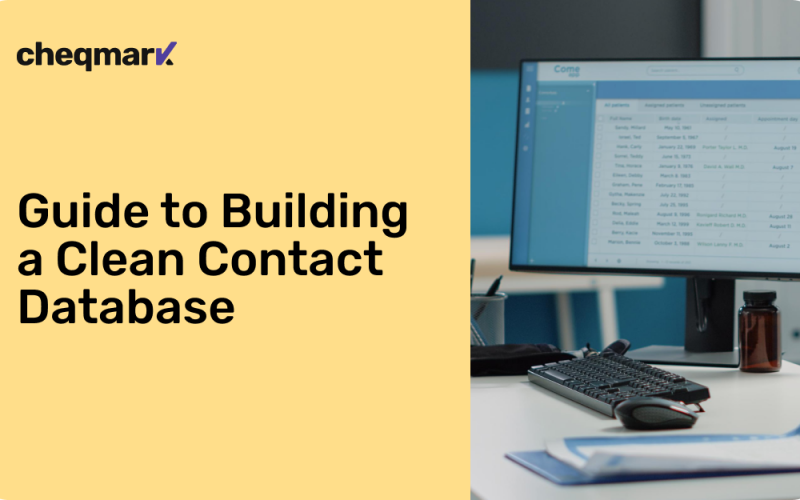Your relationships database is one of your most important business assets. But, for most small business owners, they treat it as if it were a digital junk drawer—crammed with ancient emails and duplicate entries and contacts they don’t even remember meeting.
I learned this the hard way. Two years after starting my consulting business, I attempted to run an email campaign to the “database” of 800 people in my contact list. The results? A 43% bounce rate, 3 spam complaints and precisely zero meetings booked. The issue wasn’t that no one wanted to receive my message — it was simply a matter of addressing an old, messy and outdated contact list.
If you’re an entrepreneur building a business, your contact database should receive the same level of care that you put into managing your finances or developing your product. Clean, organized contacts lead to better outreach results and stronger connections — so you can spend less time chasing down information and more time engaging with your network. Here’s how to make one that actually works.
Why the Quality of Your Contact Database Matters More Than Numbers
The typical entrepreneur is hell-bent on collecting as many business cards and LinkedIn connections as he or she can. But a pool of 1,000 contacts is nothing when you see that half of the email addresses have bounced and that you can’t remember who’s the other half.

Many reasons why quality is more important than quantity:
- Deliverability depends on accuracy. Email providers track bounce rates. Send to enough invalid addresses and your good emails start ending up in recipients’ spam folders. A single poor campaign can haunt your sender’s reputation for months.
- Time is your scarcest resource. Digging through chaotic contact lists, struggling to recall who everyone is or finding updated email addresses burns up hours that should be used in growing your business.
- Relationships require context. That guy at the conference you spoke to last year? If your database isn’t peppered with notes about where you met and what you spoke about, you’re starting from the beginning every time you make contact.
- ROI improves with relevance. And 100 tailor made messages to relevant is perfect and will outpull 1,000 generic spam blasts to old. Better information leads to better results, simple as that.
Step #1. Perform a Review of Your Existing Contacts
Clean up what you already have before adding new contacts. It can be boring, but it forms the base of everything else.
Begin by exporting your contacts from wherever they currently reside — email clients, CRM systems, spreadsheets or scattered notes. Now put them all together in one big list.
Now for the tricky part: Revisiting each contact site to ask three questions:
Is this information current?
They changed jobs, email addresses went dead and phone numbers were disconnected. If you have not got in touch with someone for more than a year, its details probably need checking.
Do I remember this person?
Is this contact relevant to my business?
Your college roommate’s cousin who inquired about your services way back when, but never reached out? Maybe not one you want to keep around in your live database. Be ruthless about relevance.
This audit could split your the contact list in half. That’s okay. 200 vetted, relevant contacts in a database is worth 800 questionable ones every time.
Step #2. Check Your Emails and Other Contact Information
After you’ve decided which contacts to save, check that their details are actually correct.
For email addresses, consider using validation tools to verify whether an address is deliverable without sending a real email. These are instruments that find misspellings/ mistyped e-mails and inactive accounts or even spam traps that could dent your sender’s score.
When you have an email address but need to verify the person behind it, you can find out who owns that email address through professional lookup tools that cross-reference email addresses with LinkedIn profiles and other professional networks. This confirms you’re reaching the right person at the right company.

Phone numbers require similar verification. Call or text to ensure they’re still live, or avail yourself of verification services that assess phone number authenticity.
Don’t skip this step. It takes a couple of hours to check 200 contacts. Repairing spam complaints and harm to sender reputation due to invalid addresses can take up to a few months.
Step #3. Enhancing Your Contacts’ Records
Just the very basics—a name, email address, some phone numbers—aren’t sufficient for us to be able to successfully do our outreach. Provide context that actually makes each contact worth something:
- Company and job title. People change roles frequently. If you have current employment information, you can better address them by name and know how to engage with their decision-making capabilities.
- Source and date added. How did you come to know this person? When? This background can be hugely helpful when writing personalized outreach. Not “I have your contact info.” It’s better, any day of the week, to start with “We met at the Austin startup conference in March.”
- Conversation notes. What did you discuss? What were they interested in? What did they say about their business challenges? These are the minor details that turn cold outreach into warm follow-up.
- Tags and categories. Segment your contacts by industry, interest, lead status or whatever makes the most sense for your business. That allows for targeted campaigns rather than one-size-fits-all blasts.
- Last contact date. Note when you last reached out. No longer will you find yourself having sent half a dozen emails to someone in the same week or ignored a hot lead for six months.
The best contact databases are built from a regularly updated contact database that refreshes information automatically, catching job changes, new email addresses, and updated phone numbers without manual work. This is how your database stays up to date without sucking in hours of your time.
Step #4. Select the Best Tools for Organization
You want a contact management system that is appropriate to the size and type of your business.
Here are the main options:
Spreadsheets (Google Sheets/Excel)
Best for: Very small businesses or solo business owners with less than 100 active contacts. Pros: Free, adaptable and customizable. Cons: Manual, no automation, hard to scale.
CRM Systems (HubSpot, Pipedrive, Salesforce)
Best for: Expanding companies with a lot of prospective customers in the sales pipeline. Pros: Automatically tracks, integrates with email and other tools, scales. Cons: Big learning curve, monthly fees, can be overkill for minimalist needs.
Email Marketing Platforms (Mailchimp, ConvertKit)
Best for: Businesses who’s main focus in email marketing. Pros: Built-in verification, segmenting tools and campaign tracking. Pros:Restricted beyond email, contacts must opt in for compliance.
Specialized Contact Enrichment Tools
Best for: Businesses in need of extensive verified contact data. Pros: Most up to date version, a lot of information, very accurate. Cons: Costs on per-contact basis, need to integrate with other tools.
For most small businesses, combining a basic CRM with a contact enrichment tool is ideal. In short, your CRM houses your relationships and captures interactions, while the enrichment enables the data to be clean and fill in.
Step #5. Set up Hygiene Habits for Contacts
A clean contact database won’t stay that way without regular upkeep. Form these habits around your workflow:
Weekly review. Spend 15 minutes a week in adding notes from conversations, updating contact information, and entering new contacts you collected that week. You wait until the end of the month and you’re going to forget a bunch of important details.
Monthly verification. Schedule verification checks on contacts you recently emailed or that are in your pipeline to reach out to, say once a month. This intercepts dated information before it becomes a deliverability challenge.
Quarterly deep clean. You should audit your entire database once a quarter. Delete contacts who unsubscribed, bounced multiple times or didn’t interact for more than a year. Rather than delete them outright, archive inactive contacts — you never know when someone might become relevant.
Document your system. Document how you do contact management. Which fields are required? What do your tags mean? How do you categorize contacts? Documentation keeps you consistent, especially if you hire people later.
Common Contact Database Mistakes to Avoid
Here’s what to avoid in your next contact database.
With the best of intentions, entrepreneurs fall predictably short keeping their contact lists current:
- Buying email lists. Never, ever buy contact lists. They are full of outdated information, people who do not want to receive them and potential spam traps. And it’s also against the law in many jurisdictions under GDPR and CAN-SPAM regulations.
- Mixing personal and business contacts. Distinguish between personal and business contacts. You wouldn’t want to inadvertently forward a sales pitch to your dentist or an update about your family to a potential client.
- Forgetting about privacy compliance. If you are gathering those emails for marketing, you need explicit opt-in consent. If you’re storing data on people who live in the EU, then it’s something you’ll want to understand. Violating privacy laws opens up legal exposure.
- Over-complicating your system. You don’t need a 50-column contact database and will never use 40 of them. Keep It Simple and Stupid, add complexity when you really need it.
Your list of contacts is years of networking. Regularly back it up to cloud storage or on a couple of different places. Its a business disaster if you lose your contacts to some technical failure.
Making the Most of Your Contact Database
Clear, organized contacts are what make smarter business development possible:
Targeted outreach campaigns. Rather than one-size-fits-all messaging, break your database out into segments of industry, past interactions or interests. Targeted messages receive far higher response rates.

Systematic follow-up. Leverage your contact notes and keep last-contact-date tracking to make sure that hot leads don’t turn cold. Add reminders to touch base at specific points in the future.
Referral generation. If you need an introduction or know someone looking for help in a different area, a well-maintained database allows you to quickly see who in your network can make it happen.
Keep a favored space in contacts’ minds without bitching about it by periodically reaching out with value adds, relevant articles, introduction or congratulations on some achievement. Your database shows you who to reach out to and for what reason.
The Bottom Line
Your contact database is a living asset that appreciates more with time – if you take care of it the right way. A database is terrible if it’s inaccurate and full of ghost names.
Begin by auditing, validating all data, enrich contacts with valuable context, select tools that fit and implementing maintenance processes. These are the things that will turn your contact database from a digital junk drawer to a growth engine for business development.
The time investment pays dividends quickly, however. Higher deliverability, better relationships and more successful outreach mean more opportunities and less time wasted on nonstarters. Thank your future self for doing it, and for creating a contact database that actually works.


